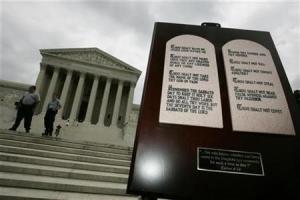Revelation 21: New Heaven and new Earth

Dr. Wernher von Braun was a German-American aerospace engineer and spaceflight visionary who played a significant role in the development of rocket technology and space exploration during the 20th century. He became a key figure in the early years of the National Aeronautics and Space Administration (NASA). He took center stage in the advancement of the Saturn V rocket, which was used to launch the Apollo missions to the moon.
Von Braun once said he had “essentially scientific” reasons for believing in life after death. He explained:
“Science has found that nothing can disappear without a trace. Nature does not know extinction. All it knows is transformation. If God applies this fundamental principle to the most minute and insignificant parts of the universe, doesn’t it make sense to assume that he applies it to the masterpiece of his creation — the human soul? I think it does.”
However, we fall short of understanding if we think God’s program of redemption in Christ is only about the soul. It’s broader still. While the forgiveness of sins, living a holy life, and going to heaven lie at the core of the Gospel’s foundational message, the good news of Jesus Christ, encompasses every aspect of existence. It isn’t focused only on individual spiritual renewal; rather it encompasses the renewal of families, communities, education, business, society, government, and more. Ultimately, it entails the transformation of the entire universe, Heaven and earth, both the celestial and terrestrial realms.
Consider what the apostle John wrote in Revelation chapter 21, verses 1 through 4:
“Then I saw a new heaven and a new earth, for the old heaven and the old earth had disappeared. And the sea was also gone. And I saw the holy city, the new Jerusalem, coming down from God out of heaven like a bride beautifully dressed for her husband. I heard a loud shout from the throne, saying, 'Look, God’s home is now among his people! He will live with them, and they will be his people. God himself will be with them. He will wipe every tear from their eyes, and there will be no more death or sorrow or crying or pain. All these things are gone forever.'”
The Book of Revelation provides a comprehensive narrative spanning the history of the church, the fate of the world, and the unique role of Israel in God’s plan. It depicts the terrifying Tribulation period, during which the Antichrist and his False Prophet wield power before being cast into the Lake of Fire. Satan is bound and imprisoned for a thousand years, during which Christ reigns literally on the earth for what is known as the Millennial Kingdom. At the end of the Millennium, Satan is released to test the nations, and many join in league with him and plan an attack on God’s people. Those allied with the Evil One face destruction by fire, after which Satan himself is cast into the Lake of Fire alongside the Antichrist and the False Prophet. This marks the beginning of the end.
As a young boy laboring for farmers in Eastern North Carolina, I often heard them invoke an old saying that resonates with the themes of Revelation chapter 20. They would say, “We’re getting in the short rows now,” signifying that we were nearing the end of the field. This colloquial expression indicated we were approaching the final rows of crops and our work would soon conclude. In other words, this part of the book of Revelation tells us that its whole narrative has advanced to a critical phase — the resolution of everything God has been doing. We have reached the gateway — the entrance into eternity.
Due to its finite nature, the concept of eternity can be challenging for the human mind to grasp. However, the Chancellor of Dallas Theological Seminary, Chuck Swindoll, shared a poignant illustration that helps shed some light on eternity’s magnitude.
Swindoll suggests that we try to imagine a solid steel ball the size of planet Earth, measuring 25,000 miles in circumference. Every one million years, a small sparrow is released to land on the ball, sharpen its beak, and then fly away, only to return another million years later to repeat the process. Despite this continual abrasion, by the time the ball would be worn down to the size of a BB, eternity would have only just begun.
J. Wilbur Chapman, the marvelous Presbyterian evangelist, who at times preached alongside evangelist D.L. Moody, wrote a poem capturing something of eternity’s meaning:
“How long sometimes a day appears!
And weeks how long they are!
Months move as if the years
Would never pass away.
But days and weeks are passing by,
And soon must all be gone,
For day by day the moments fly,
Eternity comes on.
Days, months, and years must have
an end;
Eternity has none;
It will always be as long to spend
As when it first begun.”
The apostle John describes his vision of a new heaven and a new earth, where the former heaven and earth have vanished, and there is no more sea (v.1).
Among Christians, there has been an ongoing debate with questions concerning the nature of this new heaven and new earth. Is the Scripture speaking symbolically, portraying the spiritual realm and the redeemed community of believers? Could these words signify the inauguration of a new order brought about by Christ’s triumph over sin and death? Or, should we interpret the text strictly literally? Will God make an entirely fresh physical universe, obliterating the current heavens and earth to introduce a pristine planet with a new sky and space above? Or, is it more a transformation of the existing cosmos into a state of perfection, devoid of sin and suffering?
While it’s essential not to be overly rigid in interpretation, a purely symbolic reading may not fully capture the depth of God’s redemptive work. The symbolic interpretation could, however, complement the literal or renewal interpretations, enhancing our understanding of the latter two. Nevertheless, the most accurate interpretation seems to favor a renewed or transformed creation — a view that aligns more with God’s previous acts of salvation, suggesting continuity with his overarching plan.
In his book, Exploring Revelation, John Phillips explains:
“The word ‘new’ means not merely new as to time, but also as to kind. It is a new kind of heaven and a new kind of earth, proof of which is found in the fact that the new earth will have no sea. The first heaven and the first earth are not to be annihilated; they are to be purged by fire and regenerated. Satan has defiled both spheres, and God will therefore make them anew. They are made new in the same sense that the believer is ‘a new man’ in Christ, that is, he is another man, quickened and renewed by the Spirit of God.
“The eternal state is not simply a spiritual condition destitute of locality. The earth and the heaven are fixed locations throughout eternity. There is something particularly comforting in that for us who, at present, know only mortality. The Lord Jesus promised to go and prepare a place for us of many mansions. ‘If it were not so,’ he said, ‘I would have told you’ (John 14:2, cf. 1-4). The clear implication is that, could we expect to find heaven drastically, shockingly different from the earth, then he would have told us. But it is not. We shall feel as much ease and at home in heaven as we do on earth right now. Heaven contains much with which we are fondly familiar.”
Although the sea is beloved by sailors, beachgoers, water surfers, sports enthusiasts, nature lovers, artists, writers, and romantics of every sort, the Bible often depicts the sea as something that separates people from each other and creates barriers. In both reality and symbol, the sea represents a place of considerable danger and peril. Whether fishing, shipping, or recreational boating, innumerable sea-related tragedies result in the loss of human life. In the sea, there are pathogens, pollutants, and toxins that pose serious risks to human health, including waterborne diseases, and the contamination of seafood. Several types of sea creatures have the potential to cause harm and kill humans, either through direct attacks or indirect means like venomous stings or bites. These creatures include sharks, box jellyfish, Portuguese man-o’-war, sea snakes, stonefish, cone snails, and saltwater crocodiles, to name a few. It is on the sea, that horrific storms are born: hurricanes, typhoons, and cyclones that cause vast amounts of property damage and loss of life. On this earth, that which is most beautiful can be most hazardous, and such is the sea.
Moreover, remember Revelation chapter 13 says the Antichrist comes from the sea, a place of chaos and instability — a place where life is tossed to and fro.
In his commentary on Revelation, Leon Morris says of the sea:
“For this element of unrest, this fruitful cause of destruction and death, this divider of nations and Churches, there could be no place in a world of social intercourse, deathless life, and unbroken peace. In the end, this seething cauldron, fraught with unlimited possibilities of evil, will disappear. No one lives on the sea. It is something to be crossed to arrive at one’s destination, but there is nothing permanent about it. The sea is one of seven evils John speaks of as being no more, the others being death, mourning, weeping, pain (4), curse (22:3) and night (22:5).”
What comfort and assurance for those who have made Christ their Master. On the new earth, there will be no more sea: no more isolation or loneliness, no more separation from friends and loved ones who are also in Christ, no more turmoil, no more danger, no more unpredictability, no more fear, no more dread or anxiety, no more chaos or disorder, no more evil, and no more loss of life. On the new earth, these terrible tortures will be in the past, and God’s people will forever live in a perfect world — never again to be harassed by them. Herein is the endless end of everything that would hurt God’s children.
Next, John says he saw the holy city, the New Jerusalem, coming down out of heaven like a bride beautifully dressed for her husband (v.2).
Nearly 45 years ago, when my wife walked down the aisle of Tabernacle Church in Norfolk, Virginia, to join her life with mine. I can say with absolute sincerity that as quickly as I caught my first glimpse of her in her wedding attire — her father escorting her — wearing a blusher veil that she had made with her own hands — and carrying a charming bouquet — I was utterly smitten, captivated, enraptured. In that moment, I beheld a beauty so profound that it remains unrivaled in my memory to this day. She looked as if she had just dropped out of Heaven. Better still, heaven on earth was in my heart and she was the cause of it, every adversity and agitation of life fled from me in that moment.
Leon Morris says of the apostle’s vision of the New Jerusalem coming down from heaven like a bride:
“Perhaps John has in mind that there is already a sense in which God’s people experience the heavenly city. It is this that is their bliss in the presence of a multitude of earthly distractions and difficulties. And this of which they now experience a foretaste will be perfectly realized hereafter. Heaven, will so to speak, come down to earth.”
The Bible teaches that there is a tangible city, one substantially real, which is currently under construction by Christ somewhere above, perhaps in outer space. It is to this city all the saints, regardless of the dispensation in which they lived, will ultimately go to live with God.
This is the city referenced in Hebrews chapter 11 and verse 10, where it speaks of Abraham eagerly anticipating ‘a city with eternal foundations, a city designed and built by God.’ It’s the remarkable place Jesus promised in John chapter 14 and verse 3, saying, ‘When everything is ready, I will come and get you, so that you will always be with me where I am.’ The apostle Paul also spoke of this celestial dwelling in Galatians chapter 4 and verse 26, affirming, ‘But the Jerusalem that is above is free, and she is our mother.’ In Galatians, Paul distinguishes between the earthly Jerusalem of his time and the heavenly Jerusalem, present and forthcoming. The New Jerusalem embodies freedom from sin and its consequences, and Paul metaphorically describes it as ‘our mother,’ showing that only those ‘born again’ through faith in Christ are citizens, having made it their source and destination of eternal life.
In the end, when God renews and transforms the universe, the New Jerusalem will be brought down toward the earth, maybe to orbit it, and the Bible says a loud voice from heaven announces that from henceforth God will take up residence with humanity – he will live among them (v.3).
This is none other than a divine and unceasing embrace of the sons and daughters of Adam. As David Guzik notes in the Enduring Word Commentary on Revelation chapter 21, what is seen in this text is the crescendo, if you will, of everything God has been doing since the Fall of mankind into sin. He writes:
“This succinctly states the essence of God’s desire and man’s purpose. Simply, God’s desire is to live in close fellowship with man, and man’s purpose is to be a people unto God. This is the greatest glory of heaven and the ultimate restoration of what was lost in the Fall… ‘I do not think the glory of Eden lay in its grassy walks, or the boughs bending with luscious fruit – but its glory lay in this, that the ‘Lord God walked in the garden in the cool of the day.’ Here was Adam’s highest privilege, that he had companionship with the Most High’ (Spurgeon).”
The late globe-trotting evangelist, Dr. Billy Graham, summed up this same principle this way, saying:
“Religion can be anything. But true Christianity is God coming to man in a personal relationship.”
This is what God wants — a personal relationship with each of us through his Son, the Lord Jesus Christ. This is what living in the New Jerusalem, the Heavenly City is about — God living in our midst.
Finally, when there is a new heaven and a new earth, and the New Jerusalem comes down from above and God makes his dwelling with humanity for eternity, it is said that God will wipe away every tear (v. 4).
In life, multiple, seemingly unending experiences evoke bitter tears: the death of loved ones, personal tragedies, traumatic incidents, major life transitions, empathy for others, unfulfilled aspirations and dreams, and feelings of disconnection.
It might be said that if all the tears that have fallen since the beginning of time were gathered and poured out, it would form an ocean deep and wide enough to replace the sea that will not be on the new earth.
Glory to God, there are no tears, not even a remnant of them, in God’s new world — no tears whatsoever! No one will ever weep in sorrow again for any reason and for all of eternity!
God cares about every situation that has ever grieved us. He knows every tear shed, and on that day, he will wipe them all away.
Who can comprehend the incredible scope of the Lord’s redemption – its height – its depth — its width — its length? Truly, the Lord saves to the uttermost.
Former Ambassador Alan Keyes admonished, “There’s not a single thing on offer in this all-too-temporary world for which you should ever sell your soul.”
Indeed, eternity is a long, long, long stretch … it’s never, never, never-ending. There is nothing so irresponsible, so neglectful, or so foolish, as to dismiss thinking about eternity and the need to prepare for it — because everyone is either headed for eternal delight or eternal despair.
Where will you spend eternity? If you decide for Christ, you can know where you will be in the end. The same person who penned the book of Revelation also wrote, “Believe in the name of the Son of God so that you may know that you have eternal life” (I John 5:13).
Rev. Mark H. Creech is Executive Director of the Christian Action League of North Carolina, Inc. He was a pastor for twenty years before taking this position, having served five different Southern Baptist churches in North Carolina and one Independent Baptist in upstate New York.




























